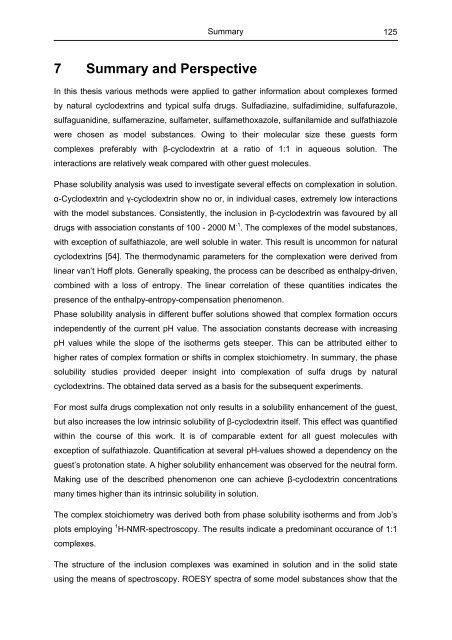Untersuchung von Cyclodextrinkomplexen - OPUS - Universität ...
Untersuchung von Cyclodextrinkomplexen - OPUS - Universität ...
Untersuchung von Cyclodextrinkomplexen - OPUS - Universität ...
Erfolgreiche ePaper selbst erstellen
Machen Sie aus Ihren PDF Publikationen ein blätterbares Flipbook mit unserer einzigartigen Google optimierten e-Paper Software.
Summary<br />
7 Summary and Perspective<br />
In this thesis various methods were applied to gather information about complexes formed<br />
by natural cyclodextrins and typical sulfa drugs. Sulfadiazine, sulfadimidine, sulfafurazole,<br />
sulfaguanidine, sulfamerazine, sulfameter, sulfamethoxazole, sulfanilamide and sulfathiazole<br />
were chosen as model substances. Owing to their molecular size these guests form<br />
complexes preferably with β-cyclodextrin at a ratio of 1:1 in aqueous solution. The<br />
interactions are relatively weak compared with other guest molecules.<br />
Phase solubility analysis was used to investigate several effects on complexation in solution.<br />
α-Cyclodextrin and γ-cyclodextrin show no or, in individual cases, extremely low interactions<br />
with the model substances. Consistently, the inclusion in β-cyclodextrin was favoured by all<br />
drugs with association constants of 100 - 2000 M -1 . The complexes of the model substances,<br />
with exception of sulfathiazole, are well soluble in water. This result is uncommon for natural<br />
cyclodextrins [54]. The thermodynamic parameters for the complexation were derived from<br />
linear van’t Hoff plots. Generally speaking, the process can be described as enthalpy-driven,<br />
combined with a loss of entropy. The linear correlation of these quantities indicates the<br />
presence of the enthalpy-entropy-compensation phenomenon.<br />
Phase solubility analysis in different buffer solutions showed that complex formation occurs<br />
independently of the current pH value. The association constants decrease with increasing<br />
pH values while the slope of the isotherms gets steeper. This can be attributed either to<br />
higher rates of complex formation or shifts in complex stoichiometry. In summary, the phase<br />
solubility studies provided deeper insight into complexation of sulfa drugs by natural<br />
cyclodextrins. The obtained data served as a basis for the subsequent experiments.<br />
For most sulfa drugs complexation not only results in a solubility enhancement of the guest,<br />
but also increases the low intrinsic solubility of β-cyclodextrin itself. This effect was quantified<br />
within the course of this work. It is of comparable extent for all guest molecules with<br />
exception of sulfathiazole. Quantification at several pH-values showed a dependency on the<br />
guest’s protonation state. A higher solubility enhancement was observed for the neutral form.<br />
Making use of the described phenomenon one can achieve β-cyclodextrin concentrations<br />
many times higher than its intrinsic solubility in solution.<br />
The complex stoichiometry was derived both from phase solubility isotherms and from Job’s<br />
plots employing 1 H-NMR-spectroscopy. The results indicate a predominant occurance of 1:1<br />
complexes.<br />
The structure of the inclusion complexes was examined in solution and in the solid state<br />
using the means of spectroscopy. ROESY spectra of some model substances show that the<br />
125

















